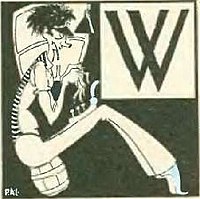SAY IT WITH SCANDAL
 E shall say it is national election day, 1928.
E shall say it is national election day, 1928.
In the office of the consolidated Times–World–Tribune (retaining the best features of each)—ah, but why attempt to penetrate the mysteries of a madhouse? Let us turn to more placid fields.
It is eleven o’clock in the morning as we step into the office of the consolidated Mirror–News–Graphic (also retaining the best features of each, including Hearts Bereft, Kute Kracks of Kunning Kiddies, and How to Beat Up Your Wife in Ten Seconds.)
The city room is more serene and tranquil than a saloon which sells nothing but near-bear. The man who does Hearts Bereft is gloomily figuring out a three-letter word meaning Japanese sash, the octogenarian who dopes the Kute Kracks and sells them to himself at one dollar a krack is playing one-handed parcheesi, and the permanent author of the Daily True Story is trying to get a week’s supply in advance so he may run up to Montreal for a couple of days and sample some fine old Scotch manufactured on Staten Island and imported via Burlington, Vermont.
There are also half a dozen reporters, trying to recover from the night before election; four rewrite men, who have abandoned hope of ever recovering; the city editor, who is reading Variety, and the assistant city editor, who is doing nothing at all except looking blank. The telephone rings, and the assistant city editor, with the air of an early martyr, answers it.
“Lemme speak to the city editor,” demands a voice.
“Who is this speaking, please?” asks the assistant, although he knows very well who it is. The journalistic Constitution provides that nobody may ever telephone anybody else on a newspaper unless that question is asked. Things look so much better that way. More swanky.
“This is the Boss,” says the caller, so he is connected.
“Hello, Mac,” says the Boss. “What's doing?”
“Well,” replies Mac diffidently, “it looks like the Repub———”
“Oh, hell!” interrupts the Boss. “Never mind that. What's doing?”
“Well,” says Mac. “’Nother Chink murder.”
“Coupla paragraphs. Chinks are stale. What else?”
“Well, old John P. Doughbags kicked off.”
“Time he did. Send a reporter around to see if there’s any woman angle to it, and if there is, splash it. Otherwise, let it ride three paragraphs.”
“And there was a woman plugged her sweetie dead up in the Bronnix.”
“Sounds grand. Good looking?”
“Nah. About fifty, and fat.”
“Never mind. Make her an ex-Follies Beauty, and play up the jealousy stuff. Dig around in the morgue and get a picture of some doll who's died or moved away or something. If nothing else happens, splash her on the front page and stick the election inside—I suppose we gotta say something about it. Be down in about an hour. G’bye.”
The best man (there is no such thing as a “star reporter” any more except in the movies) is thereupon yanked away from his autopsy into the unfortunate Chink, and dispatched to the Bronnix with a photographer. They leave, cogitating on how to run a ten-cent round-trip subway fare into a four-dollar-and-fifty-cent-expense account. This, although difficult, can be done.
About four in the afternoon the Boss arrives, that being his idea of an hour from eleven in the morning.
Matters immediately take on a feverish aspect, for it is an excellent thing to appear feverish while the Boss is present.
The Hearts Bereft authority abandons his researches into Japanese sashes and enthusiastically opens letters from optimistic citizens who would like to make the acquaintance of a young lady, 22 to 24 of age, of Jewish descent, not the flapper or gold digger type, who would appreciate a real pal.
The author of the Daily True Story, who has long ago given up hope of an advance supply and for two hours has been sitting in a state of coma, covers three sheets of copy paper with “Now is the time———”
A rewrite man, who has been listening in total apathy to a reporter’s account of an East Side fire, suddenly becomes intensely interested in finding out what it was all about, and asks questions carefully designed to sound intelligent.
The city editor drops the remains of his Western sandwich into the basket. His assistant grabs the phone and calls up a series of mythical numbers.
“Didja get that thing about the ex-Follies girl shooting her big butter-and-eggs man, Mac?” asks the Boss, for by this time everyone is firmly convinced that the middle-aged Bronx lady is a noted actress.
“Sure,” says Mac. “Only it seems she didn’t shoot him at all, but fractured his conk by busting him with a gin bottle.”
““That’s better,” commends the Boss, “Only call it champagne in the story. Then when it gets played out, We can start a campaign about Rich Revel in Dissipation, While Poor Suffer in Winter’s Icy Grip.”
It is now close to press time, since a morning tabloid must necessarily appear on the streets at five in the afternoon, The Boss puts on his hat and coat to go out for a bite of lunch, from which he will return at ten-thirty.
For a moment he stands locking from the window at the newsboys howling the afternoon papers. The crowds in front of the bulletin boards grow more vociferous. New York at large is preparing to succumb to its once-in-four-years period of hysteria.
“Lord, but this is a dead day!” says the Boss.
